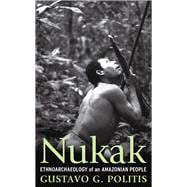
Note: Supplemental materials are not guaranteed with Rental or Used book purchases.
Purchase Benefits
What is included with this book?
| Preface | p. 11 |
| Acknowledgments | p. 13 |
| Illustrations | p. 17 |
| Tables | p. 23 |
| Introduction | p. 25 |
| The Nukak and the Makú | p. 31 |
| Recent History of the Nukak | p. 36 |
| History of Contact | p. 38 |
| Previous Studies | p. 43 |
| Environment | p. 47 |
| Physiography and Soils | |
| Plant Physiognomy of the Environments in Nukak Territory | |
| Final Considerations | p. 53 |
| Theory and Methods: Ethics and Techniques | p. 55 |
| On Ethnoarchaeology | p. 58 |
| Ethnoarchaeology in South America | p. 63 |
| Fieldwork | p. 66 |
| Data Collection: Methods, Techniques, and Problems | p. 69 |
| Ethics | p. 72 |
| Concluding Remarks | p. 74 |
| Sociopolitical Organization and Cosmology | p. 77 |
| Sociopolitical Organization | p. 77 |
| Ideology and Cosmology | p. 84 |
| Final Considerations | p. 92 |
| Shelters and Camps | p. 99 |
| Architecture of the Shelters | p. 100 |
| The Residential Camp | p. 106 |
| The Construction of Residential Camps | p. 114 |
| Other Types of Camps | p. 119 |
| Transitory Camps | |
| Small Shelters Peripheral to Residential Camps | |
| Small Shelters between Camps | |
| Rectangular Constructions in Chagras, or the "House of the Tapir" | |
| Bridges | |
| Discussion | |
| Final Remarks | p. 127 |
| The Use of Space and Discard Patterns | p. 131 |
| Residential Camp Activity Areas | p. 132 |
| Discard Patterns during Residential Camp Occupation | p. 137 |
| Abandonment Refuse | p. 145 |
| The Symbolic and Communicative Dimension of Waste | p. 152 |
| Discussion | p. 153 |
| Residential and Logistical Mobility: Daily Foraging Trips | p. 161 |
| The Multiple Dimensions of Territory | p. 162 |
| Residential Mobility | p. 165 |
| Logistical Mobility | p. 170 |
| Daily Foraging Trips | p. 171 |
| Final Considerations | p. 179 |
| Traditional Technology | p. 189 |
| The Nukak and the Adoption of Western Technology | p. 193 |
| Traditional Technology | p. 196 |
| Hunting and Fishing Weapons | |
| Other Elements Used in Food Procurement | |
| Plant Product Procurement and Food Preparation Utensils | |
| Furnishings and Accessories | |
| The Social and Ideological Dimensions of Nukak Technology | p. 224 |
| Final Considerations | p. 229 |
| Subsistence | p. 237 |
| Nondomesticated Plants | p. 240 |
| Animal Resources | p. 256 |
| Insect and Insect By-Product Resources | p. 263 |
| Fish and Aquatic Animals | p. 267 |
| Cultivation | p. 275 |
| Food from the Colonos | p. 278 |
| The Ideational Aspect of Food | p. 278 |
| The Annual Circle and the Creation of Wild Orchards | p. 281 |
| Discussion | p. 285 |
| Conclusion | p. 288 |
| Animal Exploitation, Processing, and Discard | p. 291 |
| Hunted and Taboo Animals | p. 294 |
| Hunting and Processing Strategies | p. 300 |
| White-Lipped Peccary | |
| Monkey | |
| Tortoise | |
| Birds | |
| Caiman | |
| Bone-Discard Pattern | p. 315 |
| Archaeological Visibility of Butchering Patterns and Bone Discard | p. 316 |
| Transport | p. 319 |
| Conclusions | p. 321 |
| Final Considerations | p. 325 |
| The Nukak as Hunter-Gatherers | p. 325 |
| Territory and Mobility | p. 329 |
| The Use of Plants | p. 333 |
| Technology | p. 335 |
| Hunting and Food Taboos | p. 337 |
| The Western View of Amazonian Hunter-Gatherers | p. 341 |
| Final Words | p. 343 |
| Sample of Daily Foraging Trips | p. 345 |
| Patterns of Bone Representation and Surface Bone Modification Caused by Nukak Prey Acquisition | p. 357 |
| Material and Methods | p. 358 |
| Sample Analysis | p. 362 |
| Discussion | p. 366 |
| Conclusions | p. 373 |
| Bibliography | p. 377 |
| Index | p. 407 |
| About the Author | p. 412 |
| Table of Contents provided by Ingram. All Rights Reserved. |
The New copy of this book will include any supplemental materials advertised. Please check the title of the book to determine if it should include any access cards, study guides, lab manuals, CDs, etc.
The Used, Rental and eBook copies of this book are not guaranteed to include any supplemental materials. Typically, only the book itself is included. This is true even if the title states it includes any access cards, study guides, lab manuals, CDs, etc.